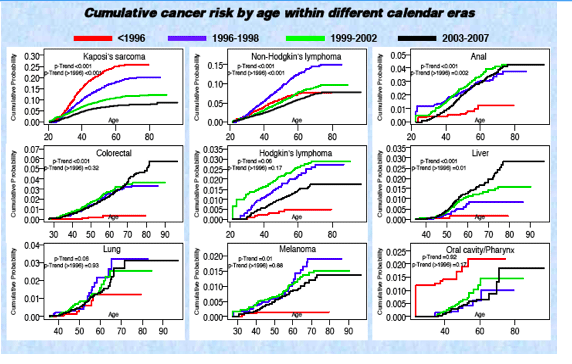 |
 |
 |
| |
Trends in Cumulative Incidence of Cancer among HIV-infected Patients in North America: high cancer rates in HIV+
|
| |
| |
- increases over time in anal, colorectal and liver cancers and melanoma; KS 10%, NHL 7.7%
Reported by Jules Levin
CROI 2010 Feb 16-19 SF
Michael J. Silverberg1, Bryan Lau2,3, Gypsyamber D'Souza3, Eric A. Engels4, John Gill5, James J. Goedert4, Gregory D. Kirk2,3, Amy Justice6,7, and Robert Dubrow6,7for the North American AIDS Cohort Collaboration on Research and Design (NA-ACCORD)1 Kaiser Permanente Northern California, Oakland, CA, USA; 2 Johns Hopkins School of Medicine, Baltimore, MD, USA; 3 Johns Hopkins School of Public Health, Baltimore, MD, USA; 4 National Cancer Institute, Rockville, MD, USA;5 University of Calgary, Calgary, Alberta, Canada; 6 Yale School of Public Health, New Haven, CT, USA; 7 Yale School of Medicine, New Haven, CT, USA
"we observed increases over time in anal, colorectal and liver cancers and melanoma..... our results more accurately describe the overall risk of cancer by considering the declining mortality risk as a competing event"
"After 1996, the cumulative risks by age 60 were 10.6% for KS (7.4% in 2003-2007), 7.7% for NHL (5.8% in 2003-2007), 3.0% for anal, 2.4% for colorectal, 2.0% for Hodgkin's lymphoma, 1.5% for lung, 1.1% for liver, 0.9% for melanoma, and 0.8% for oral cavity/pharynx"

ABSTRACT
Background: Increasing incidence of certain cancers in HIV+ pts has been reported, such as for anal and liver cancers and Hodgkin's lymphoma. However, standard survival approaches that do not account for competing events such as death tend to overestimate cumulative incidence for the event of interest. Here, we provide improved estimates of cumulative cancer incidence by accounting for the competing risk of death which has declined in the antiretroviral therapy (ART) era.
Methods: More than 96,000 HIV+ adults from 19 participating cohorts in NA-ACCORD were followed from 1/1988-12/2007 for seven more common non-AIDS-defining cancers (NADC) and two AIDS-defining cancers (ADC). Cancers were ascertained separately by cohort from medical records, histopathology, self report, or cancer registry linkage. We estimated the cumulative incidence of cancers stratified by calendar era using non-parametric estimators for competing risk events, with age as the time scale.
Results: We observed significant decreasing trends over the entire follow-up period for Kaposi's sarcoma (KS) and non-Hodgkin's lymphoma (NHL), and increasing trends for anal, colorectal and liver cancers and melanoma. After 1996, the cumulative risks by age 60 were 10.6% for KS, 7.7% for NHL, 3.0% for anal, 2.4% for colorectal, 2.0% for Hodgkin's lymphoma, 1.5% for lung, 1.1% for liver, 0.9% for melanoma, and 0.8% for oral cavity/pharynx. In the ART era, decreasing trends for KS and NHL, and increasing trends for anal and liver cancers remained significant (P<0.05).
Conclusions: Cumulative cancer incidence by age 60 is a potentially useful clinical measure since it approximates lifetime risk in this population. Using this measure, we observed increases over time in anal, colorectal and liver cancers and melanoma. A limitation of the analysis was that secular trends in other factors were not considered, such as cancer screening, smoking, or underlying viral co-infection rates. However, our results more accurately describe the overall risk of cancer by considering the declining mortality risk as a competing event in a large cohort collaboration representative of the North American HIV epidemic.









|
| |
|
 |
 |
|
|